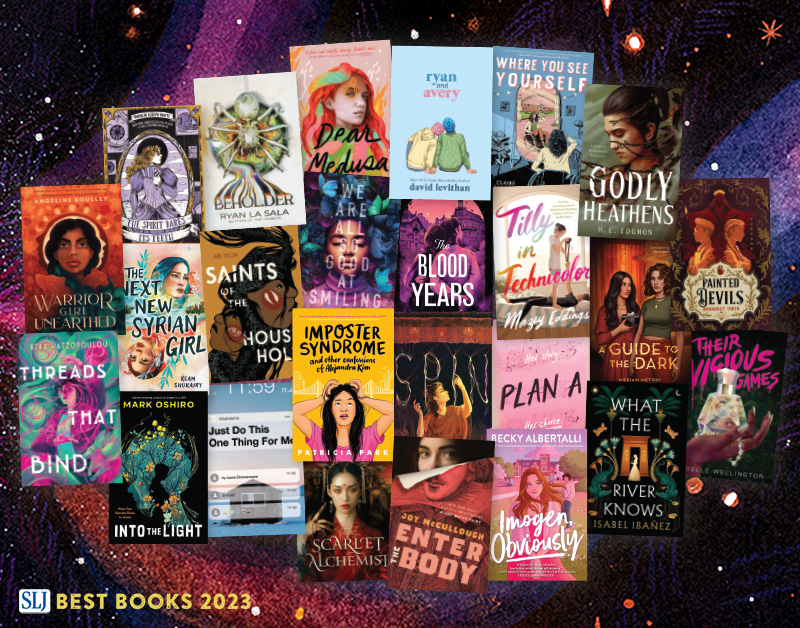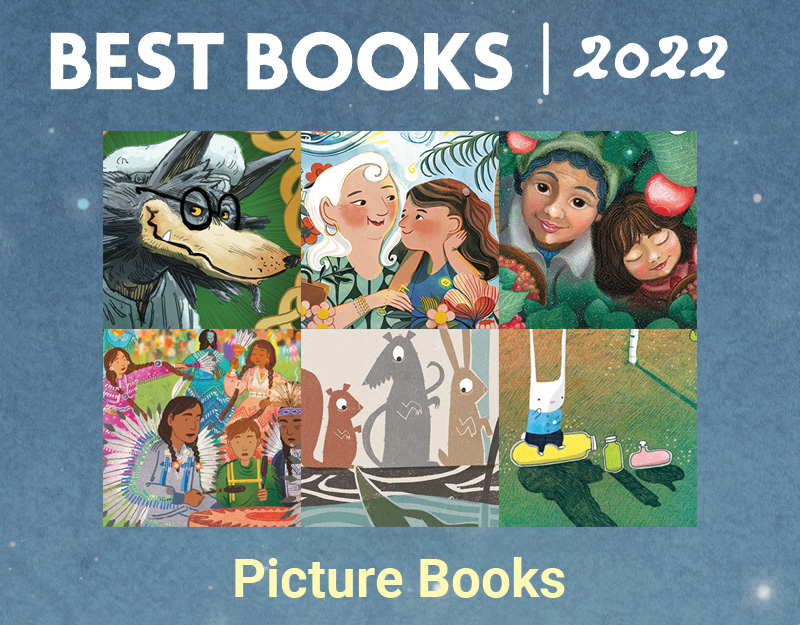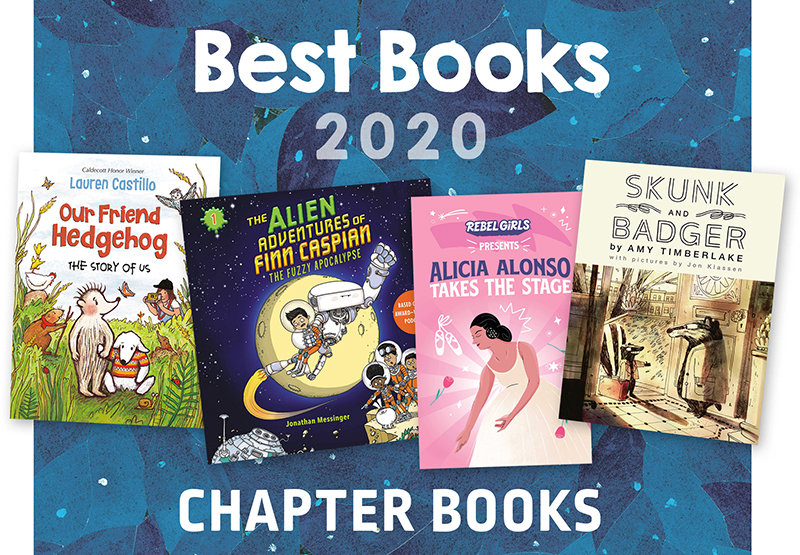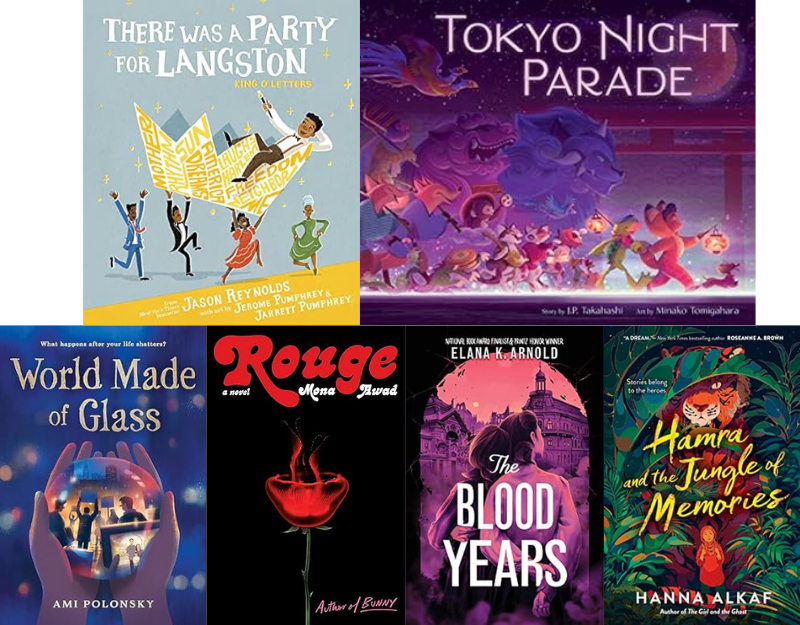Shelter
Written by Celine Claire and Illustrated by Qin Leng
Published by Kids Can Press in 2017
ISBN 978-1-77138-927-3
Grades PreK – 6
Book Review
Day begins as usual in a forest community, until the animals hear the news…. “A STORM IS COMING!” A flurry of preparations ensue and all brace for the storm. Safely ensconced in his well-stocked den, Little Fox wonders, “What if others are still outside?” And in fact, two strangers are out in the foul weather. Big Brother and Little Brother, who are bears, stagger against the wind, approaching animal homes with polite requests for warmth, for food, for shelter. Their requests are framed as exchanges, for example: “The wind is cold. In exchange for some tea, could we warm ourselves by your fire?” But at each door, they are turned away. Only Little Fox has something to offer; he chases after the bears, proffered lantern in hand. Soon the storm conditions change and the tables are turned; the falling snow creates a cozy shelter on the hillside for the bears, but threatens collapse for the fox family home. Animals are clearly stand-ins for people in this tale, and the conclusion to this beautiful and fable-like story bolsters our faith in community. Qin Leng’s watercolor and ink illustrations lend emotional depth and atmospheric intensity to Celine Claire’s elegant text. This is the book we need right now, for so very many reasons….. read it with your students and then talk about how we all can work together to offer shelter to those around us.
Teaching Ideas: Invitations for Your Classroom
Grades PreK and Up
Reader’s Theater. Shelter is a title that is well suited to dramatization. Work with your students to develop a performance. Students can create a reader’s theater script or take things a few steps further, adding scenery, props, and music. The powerful message that Shelter sends about the importance of community and supporting one another is likely to have even greater impact on your students when they have the opportunity to take on the roles of the characters through performance art.
ADVERTISEMENT
ADVERTISEMENT
Animals in Inclement Weather: A Duet Model Reading. In an earlier Classroom Bookshelf entry, we featured Over in the Wetlands: A Hurricane-On-the-Bayou Story, a nonfiction text that adopts the structure of a familiar nursery rhyme (“Over in the Meadow”) and presents the actions that bayou animals take to prepare for a hurricane. Like Shelter, this is a work of fiction; however in this book the animals are not anthropomorphized. They behave as animals do in the natural world. After reading and comparing these two texts, invite a local naturalist to come talk to your class about how animals in your area behave in inclement weather. Have students prepare questions in advance, make notes during the talk, and follow up by creating a visual display or a school newspaper article to share their learning with your community.
A Storm Text Set. Work with your school or public librarian to gather a collection of picture book titles that support an exploration of the impact of storms. As you read the titles with your students, consider how they represent: preparations for the storm, the experience of the storm itself, and the impact / after-effects of inclement weather. Decide whether you will focus specifically on hurricanes in response to recent events, or whether you will cast a wider net including books about about other types of storms. Renee Watson’s fictional picture book A Place Where Hurricanes Happen and Myron Uhlberg’s A Storm Called Katrina are both powerful explorations of the effects of Hurricane Katrina on young people. Should you choose to cast a wider net, consider including titles such as Patricia Polacco’s Thunder Cake, Jonathan Bean’s Big Snow, Seymour Simon’s nonfiction weather series, Joyce Sidman’s Before Morning, and Blizzard by John Rocco. After experiencing the texts in the text set, students create illustrated memoirs about a storm that they have experienced.
Illustrating Stormy Weather. The act of creating art can help children to process complex emotions. After reading Shelter, offer your student various media (ink, watercolor, fingerpaints, charcoal) with which to create images of storms / stormy weather. You may want to offer students the opportunity to view artists’ images for inspiration – search the major museums online for images such as The Storm by Pierre-August Cot , A Storm by Georga O’Keefe, and Approaching Thunderstorm by Martin Johnson Heade. Ask students to present their finished works of art and create a gallery display in your classroom.With so many storms in the news this summer and fall, students might take particular comfort in this activity.
Emergency Preparedness. The storms that have recently affected our country may spark anxiety in students. Take some time to make sure that your students know that there are many measures in place to support their safety during natural disasters. Set up an opportunity for your students to speak with a public official in charge of emergency preparedness either through an in person visit or a Skype interview. Develop questions ahead of time and follow up the conversation with action steps. Be sure to include questions about what plans are in place for the most vulnerable populations: children, elderly, the homeless, and those living in less permanent structures. What shelters are available and how are they maintained and made accessible? What can students do to be sure their families are prepared? What resources are available? What kind of emergency kit can they develop at the ready at their home? At their school?
ADVERTISEMENT
ADVERTISEMENT
A Helping Text Set. Shelter is an excellent title to include in text set that features characters (both fictional and real) who help. You could cast a wide net, or looks specifically for kid characters who offer service. While reading the text set, make note of how the author represents the relationship between the helper and and the one being helped, and how/whether each is being portrayed with dignity. What does each person stand to gain from their interactions? Start building your text set with two additional books featured on The Classroom Bookshelf: Matt de la Pena’s Last Stop on Market Street and George Ancona’s photo essay Can We Help? Kids Volunteering to Help Their Communities. This text set study is a clear invitation for your students to identify ways that they can help – in their homes, in their classrooms, and in their communities.
Sharing. Shelter sends a strong message on the benefits of sharing. As the strangers approach each home, they offer what they have to share in exchange for something that they need. Make a sharing wall in your classroom. Ask each student to identify something that they have that they are willing to share. Move beyond tangible items to include knowledge, skills set, artistic abilities that they can offer to others. Ask student to illustrate their offerings and create a visual display that celebrates the many ways that members of your classroom community can share together.
Grades 4 – 6
Critical Literacy
Basic Needs. Reread Shelter, inviting students make a list of the requests made by the strangers – they ask for shelter (warmth), food, and light and are turned away. Ask student to spend some time writing independently, responding to the prompt: “What do you need to survive and thrive?” Allow students to share their responses (respecting the privacy of students who choose not share) and create a list of basic needs. Discuss which needs are concrete, like food and shelter, and which are abstract, like freedom and inclusion. Consider how these needs are met within your home, school, and town/city communities. Share with students the United Nations Universal Declaration of Human Rights. Consider this global statement, but then bring the conversation back to a more local level. Reviewing the list of needs created by your students, develop an action plan to make sure that these needs are met in your classroom community. As an extension, consider examining multiple perspectives on the slogan “America First “in relation to the theme and concepts in Shelter and the United Nations declaration.
Immigration / Refugee Text Set. Shelter can also be used in a text set on the refugee experience and immigration. Ask your students why the animals approached by the strangers are unwilling to help? What might make someone turn away another person in need? What fears might drive us to reject others? Alternatively, what might we gain when we welcome newcomers to our community? When we act with compassion rather than with rejection? For additional text resources to support the development of a text set on the immigration / refugee experiences, please see our entry titled Love in Action: Children’s Books to Promote Hope and Counter Fear.
Further Explorations
Online Resources
New York Times: Amid Chaos of Storms
New York Times: Saving Pets is Paramount for Many Fleeing Tropical Storm Harvey
https://www.nytimes.com/2017/08/28/us/harvey-pets-animals.html
For Houston’s Homeless: A Terrifying Night Under Siege by Hurricane Harvey
https://www.nytimes.com/2017/08/27/us/hurricane-harvey-homeless-houston.html
Universal Declaration of Human Rights
http://www.un.org/en/universal-declaration-human-rights/
Books
Bean, J. (2013). Big snow. New York: Farrar, Straus, & Giroux.
Polacco, P. (1990). Thunder cake. New York: Putnam & Grosset.
Rocco, J. (2014). Blizzard. New York: Hyperion.
Rose, C.S. (2015). Over in the wetlands: A hurricane-on-the-bayou story. Ill. by R. Dunlavey.
Sidman, J. (2016). Before morning. Ill. by B. Krommes. Boston: Houghton Mifflin Harcourt.
Uhlberg, M. (2011). A storm called Katrina. Ill. by C. Bootman. Atlanta, GA: Peachtree.
Watson, R. (2010). A place where hurricanes happen. Ill. by Shadra Strickland. New York: Random House.
Filed under: Fiction Picture Books
About Erika Thulin Dawes
Erika is a professor of language and literacy at Lesley University. A former classroom teacher, reading specialist, and literacy supervisor, she now teaches courses in children’s literature, early literacy, and literacy methods. Erika is the co-author of Learning to Write with Purpose, Teaching with Text Sets, and Teaching to Complexity.
ADVERTISEMENT
ADVERTISEMENT
SLJ Blog Network
One Star Review, Guess Who? (#202)
This Q&A is Going Exactly As Planned: A Talk with Tao Nyeu About Her Latest Book
Exclusive: Giant Magical Otters Invade New Hex Vet Graphic Novel | News
Parsing Religion in Public Schools
Take Five: LGBTQIA+ Middle Grade Novels
ADVERTISEMENT








